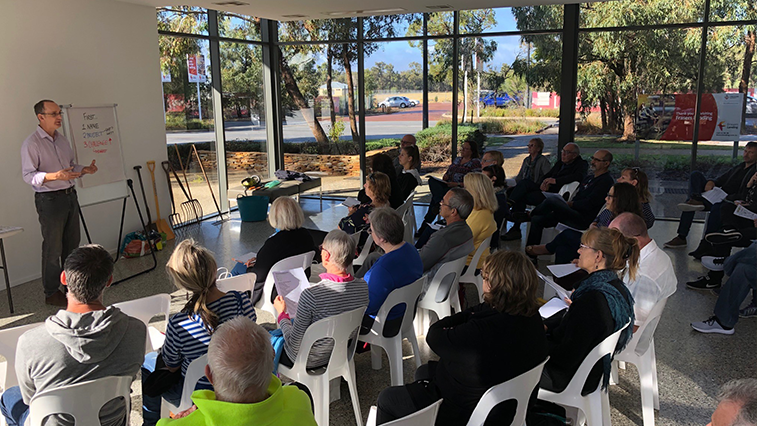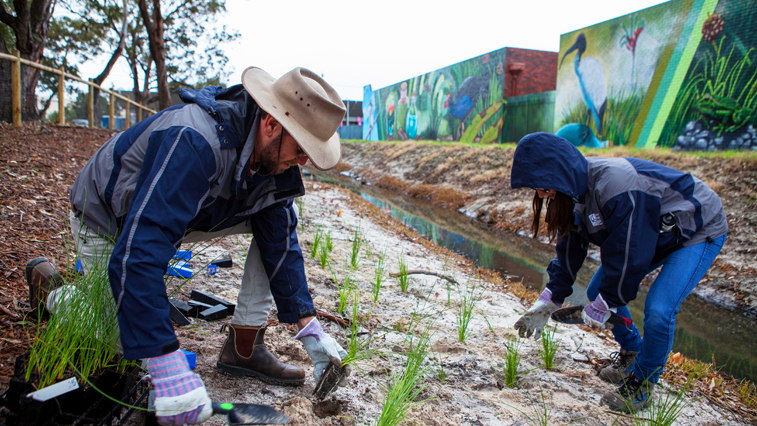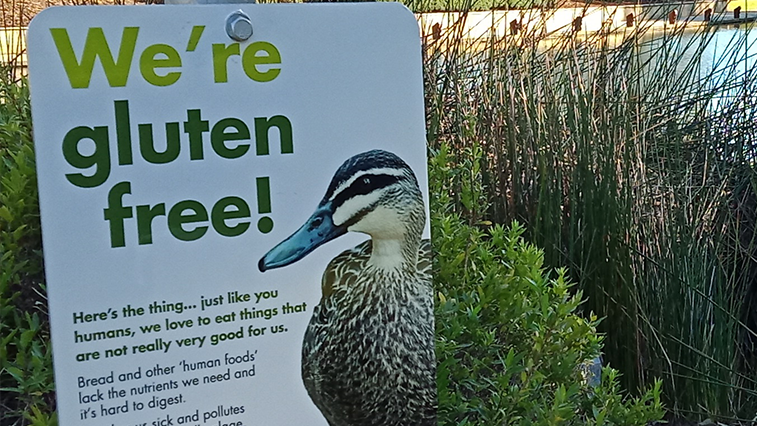Waterwise Gold Councils saving water to create liveable communities
Waterwise councils are saving water every day through innovative technologies and initiatives that contribute to creating liveable and waterwise communities.
Find out about the various water saving ways Waterwise Gold Councils are making a difference through community programs, improving local water quality and biodiversity, maintaining public open spaces and streetscapes and installing water efficient fixtures.
Community programs
Many of our Waterwise Councils provide education, training materials and verge rebates for residents to improve water efficiency and build waterwise communities. Through community programs, participants learn about how to improve water efficiency in their homes and gardens and the innovative ways in which they can reduce their water use.
The City of Vincent launched its Adopt a Verge program in 2014, which has now helped over 400 households convert turfed or weedy verges into waterwise native gardens.
These new waterwise gardens provide more aesthetically pleasing verges, use less water and food and provides habitats for urban wildlife like birds and insects.
The City’s participation in the Waterwise Council Program has provided access to additional funding to support its verge program, allowing more local households to benefit than would otherwise have been possible.
The City of Mandurah’s popular Waterwise Verge Program has transformed nearly 200 verges into waterwise gardens since 2017, with over 220 community members involved.
Participants are invited to an informative workshop and are given a variety of native waterwise plants and mulch for their verges. The program is offered to homeowners and residents of the City of Mandurah and is partly funded and fully supported by Water Corporation.
The City also runs workshops to help residents understand how small changes can have a big impact. This includes responsible fertiliser application and protecting local waterways through community initiatives like the Blue Crab School Engagement Program. The program talks to local students about how they can look after the water in the City and how nutrients, hydrocarbons and litter that washes down drains, can potentially harm the aquatic environments.
The City of Swan supports its local community by providing the very popular Thinking Green sustainable living workshop series, to improve water literacy and reduce water use at home and in the garden for its residents.
The City’s officers get out and about at large events with the Think Green mobile education trailer. They share information and engage the community in activities related to improving water quality and increasing water efficiency.
The City also provides library workshops, school visits and training opportunities for Friends Groups and Catchment Groups. Volunteers from over 30 bushland volunteer groups in the City of Swan have helped get innovative projects off the ground.
The Town of Cottesloe have produced a Waste and Sustainability Calendar that invites local schools to create artwork for its environmental events and to be involved in local tree-planting activities. They also support local sporting groups, clubs and restaurants with access to annual eco audits and water audits that provide practical solutions to save water.
A number of other Waterwise Councils also provide waterwise gardening workshops for residents to learn about waterwise practices. The City of Stirling engages with 22 local schools through their Living Green Schools Program, to educate young residents about the importance of water conservation and sustainability.
The Town of Cambridge provides waterwise gardening workshops in collaboration with its Waterwise Verge Makeover Program to aid in establishing waterwise gardens in streetscapes. While Shire of Serpentine Jarrahdale residents are encouraged to create waterwise verges vegetated with local native plants. This works hand-in-hand with the shire’s Free Verge Plant Program, which provides free local native seedlings to residents for planting on their verges.

Waterwise workshop - City of Mandurah
Water saving fixtures
Many Waterwise Councils have installed water-efficient fixtures, which save water and money without compromising performance. Some examples include waterwise taps or showerheads, greywater systems that capture and reuse water or waterless toilets. Residential leaks in Perth alone can waste around the equivalent of 700 million buckets of water per year, with leaking taps wasting up to 10,000L per year.
The City of Joondalup run a leak detection project, where up to 15 buildings are identified each year for leak detection through manual water meter readings while buildings are vacant. This method is useful for identifying long-term slow leaks that can often go unnoticed.
In addition, leaks are identified on an ongoing basis through checking of incoming billing data to identify any abnormalities. This can help identify new large leaks in a timely manner. All identified leaks are rectified to ensure minimal water is wasted.
Over 25 buildings have been upgraded with waterless urinals through the City’s Waterless Urinal Upgrade Project. This involves the removal of existing urinal stalls, reconfiguring pipework and the installation of the waterless urinals in alignment with the City’s building refurbishment schedule.
Flow restrictors have also been installed in the City’s four largest buildings (Joondalup Administration Building, Craigie Leisure Centre, Joondalup Library and Works Operation Centre) and continue to be installed across the City’s smaller community facilities.
The City has also begun the process of installing gully soakwells and swale gardens next to roads and in car parks to allow stormwater infiltration into the local groundwater, thereby reducing the amount of irrigation needed for street trees.
The City of Cambridge has installed water logging and monitoring systems in council and community facilities to help effectively identify leaks and problem areas.
The Council believes if you can measure it, you can manage it! Data loggers have provided a visual representation of leaks and water consumption to allow leaks to be repaired quickly and upgrades for facilities prioritised.
The City’s Irrigation Management Program undertake regular irrigation audits and improvements, with the assistance of weather stations and wetting agent dosing stations across the majority of sports fields in the City.
Supporting the local environment
Waterwise Councils have the opportunity to work collaboratively with us and the Department of Water and Environmental Regulation to restore and enhance the value of their green spaces and local environment.
For many Councils, their relationship to water is closely linked to the environment and opting into the Waterwise Council Program has led to an improvement in the way they sustain wetlands, parks and natural spaces. Many of the practices adopted include hydrozoning, groundwater management, nutrient control and cross-organisational collaboration.

Revegetation at Russell St Living Stream - City of Bayswater
The City of Bayswater has constructed a number of living streams and micro wetlands within its local catchment to support the aquatic biodiversity and health as a Swan River council. The City’s local environment is also supported by waterwise park management including hydrozoning, which is the practice of grouping vegetation into categories with similar water requirements to enable more efficient and responsible irrigation.
With a common goal to improve the environment and community outcomes, the city has seen unprecedented collaboration across all of WA's water management organisations, resulting in the multi-award-winning Bayswater Brook Catchment Management Plan. The keystone project of the plan was the restoration of Eric Singleton Bird Sanctuary (ESBS). The aim was to address several environmental and ecological problems and to restore a degraded wetland and improve water quality entering the Swan River from the Bayswater Brook Catchment. The result was a civil re-construction of the ESBS wetland, which will prevent 1.35 tonnes of nitrogen, 200kg of phosphorous, and around 40 tonnes of sediment and other rubbish from entering the Swan River each year.
The Sanctuary is now home to a variety of different birds including ducks, pelicans, white-faced herons, swallows, honeyeaters, reed dwellers and hawks. At dusk, hear the raucous laughter of kookaburras and the croaking frogs over its 4 hectares.
The Port Coogee Groundwater Interception Drain has been one of the Cockburn City’s cornerstone projects. It now diverts nutrient-rich stormwater onto local public open spaces and prevents it from entering the marina. The project also reduces the city’s groundwater use providing a sustainable non-potable water source.
The City of Mandurah, which has been a Waterwise Council for over 10 years, recognises that alternative water sources are important in response to climate change. The city has worked to identify and actioned several recycled water schemes, in collaboration with us. This includes the city’s Managed Aquifer Recharge (MAR) Project, that enables the use of fit-for-purpose water for its green space assets. The soon to be completed MAR Project will use the natural aquifer system to store water over wet winter months for future use during hot, dry summers. A total of 110 hectares of greenspace in north Mandurah will use MAR as a sustainable climate-independent solution for irrigation.

Signage informing residents about the local ecology - City of Mandurah.
One of the city’s practices is the review and maintenance of Gross Pollutant Traps (GPTs) and trash racks in drains to ensure litter and debris are intercepted to maintain water quality in local rivers and brooks. All known GPTs are cleaned out twice per financial year, and a register is used to keep track of GPTs and updated when new ones are added or replaced. To further support its environmental sustainability vision, the city has developed management plans and erosion control designs for reserves and waterways.
One of the town’s main philosophies is to meet the needs of the community through collaboration and genuine consultation. The town developed it’s sustainability strategy by involving community groups, residents and schools. Current and future water actions are based on the actions identified in the strategy according to community needs.
Irrigation plans & waterwise landscaping practices
Climate change is expected to further increase temperatures and reduce rainfall in the future. A reduction in water availability can lead to increased water demand as more irrigation will be required to maintain amenity in parks and landscaped areas.
Waterwise Councils are doing their bit by managing water sources responsibly and utilising best-practice smart irrigation technology, waterwise landscaping, and planning water sensitive urban designs.
Recently the city has installed 3 weather stations and is installing irrigation controllers in its parks, which link to a web-based central control system. The weather stations collect data on air temperature, relative humidity, wind speed, wind direction, atmospheric pressure, yearly rainfall, solar radiation and evapotranspiration. Data collated from the weather stations can be programmed to adjust irrigation programs for parks automatically. All irrigation controllers are remotely accessed through the central control system, allowing for more responsive irrigation practices.
Through 2 of their key projects, the shire aims to divert stormwater from a major road upgrade into detention basins (to be cleaned by nutrient stripping vegetation before entering local waterways), and also divert runoff from a sporting field upgrade away from natural area reserves into the stormwater system.
Landscaping practices from the town also include use of native plants when replanting, which in one location on the foreshore has reduced water use significantly. Irrigation at this site may be removed in the future. This is also the case for planted roundabouts, where low water demand plants have been used which can thrive with only a small amount of water.
Recently, the town took over the care, control and management of a new reserve. A water meter was installed on the irrigation system so that water usage can be recorded and reported. The town has identified some other locations that could also be sub-metered to improve irrigation monitoring and reduce landscaping water consumption.
The City of Vincent has implemented an Ecozoning Program, which has supported the conversion of underutilised turfed areas of public open space into waterwise native gardens. It now provides a home for the local bees and native insects.
Home improvements have also been achieved for wildlife by the re-engineering of the lakes at the iconic Hyde Park, which now use significantly less groundwater to keep them full.